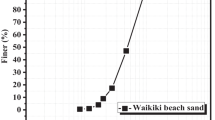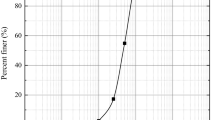Abstract
Calcareous sands have abundant intraparticle pores and are prone to particle breakage. This often leads to poor engineering properties, which poses a challenge to coastal infrastructure construction. A study using bio-cementation to improve the engineering properties of calcareous sand is presented in this paper. The macro- and microscopic properties of bio-cemented calcareous sand were characterized by drained triaxial tests and scanning electron microscopy observations. Experimental results show that the precipitated calcium carbonate can effectively fill the intra- and interparticle pores and bond adjacent particles, thus enhancing the shear strength of calcareous sand. The special structures (e.g. abundant intraparticle pores and rough surface) and mineral components (i.e. calcium carbonate) of calcareous sand are beneficial for improving bacterial retention in soil, which leads to a relatively uniform and dense calcium carbonate distribution on the sand particle surface, exhibiting a layer-by-layer growth pattern. This growth pattern and the abundant interparticle pores would result in less effective calcium carbonate. The strength enhancement of bio-cemented calcareous sand is significantly lower than that of bio-cemented silica sand at the same calcium carbonate content, which may be caused by the differences in the following: (a) soil skeleton strength; (b) the amount of effective calcium carbonate; and (c) interparticle pore-filling of calcium carbonate.












Similar content being viewed by others
References
Al Qabany A, Soga K, Santamarina C (2012) Factors affecting efficiency of microbially induced calcite precipitation. J Geotech Geoenviron Eng 138(8):992–1001
Brandes HG (2011) Simple shear behavior of calcareous and quartz sands. Geotech Geol Eng 29:113–126
Bu CM, Wen KJ, Liu SH, Ogbonnaya U, Li L (2018) Development of bio-cemented constructional materials through microbial induced calcite precipitation. Mater Struct 51:30. https://doi.org/10.1617/s11527-018-1157-4
Cieśla J, Bieganowski A, Janczarek M, Urbanik-Sypniewska T (2011) Determination of the electrokinetic potential of Rhizobium leguminosarum bv trifolii Rt24. 2 using Laser Doppler Velocimetry—a methodological study. J Microbiol Methods 85(3):199–205
Cheng L, Shahin MA, Chu J (2019) Soil bio-cementation using a new one-phase low-pH injection method. Acta Geotech 14:615–626
Cheng L, Shahin MA, Cord-Ruwisch R (2014) Bio-cementation of sandy soil using microbially induced carbonate precipitation for marine environments. Géotechnique 64(12):1010–1013
Chu J, Ivanov V, Naeimi M, Stabnikov V, Liu HL (2014) Optimization of calcium-based bioclogging and biocementation of sand. Acta Geotech 9(2):277–285
Consoli NC, Cruz RC, da Fonseca AV, Coop MR (2012) Influence of cement-voids ratio on stress-dilatancy behavior of artificially cemented sand. J Geotech Geoenviron Eng 138(1):100–109
Cui MJ, Lai HJ, Hoang T, Chu J (2020) One-phase-low-pH enzyme induced carbonate precipitation (EICP) method for soil improvement. Acta Geotech. https://doi.org/10.1007/s11440-020-01043-2
Cui MJ, Zheng JJ, Zhang RJ, Lai HJ, Zhang J (2017) Influence of cementation level on the strength behaviour of bio-cemented sand. Acta Geotech 12:971–986
Deng WN, Wang Y (2018) Investigating the factors affecting the properties of coral sand treated with microbially induced calcite precipitation. Adv Civ Eng. https://doi.org/10.1155/2018/9590653
DeJong JT, Fritzges MB, Nüsslein K (2006) Microbially induced cementation to control sand response to undrained shear. J Geotech Geoenviron Eng 132(11):1381–1392
DeJong JT, Mortensen BM, Martinez BC, Nelson DC (2010) Bio-mediated soil improvement. Ecol Eng 36:197–210
DeJong JT, Soga K, Banwart SA, Whalley WR, Ginn TR, Nelson DC, Mortensen BM, Martinez BC, Barkouki T (2011) Soil engineering in vivo: harnessing natural biogeochemical systems for sustainable, multi-functional engineering solutions. J R Soc Interface 8:1–15
Do J, Montoya BM, Gabr MA (2019) Debonding of microbially induced carbonate precipitation-stabilized sand by shearing and erosion. Geomech Eng 17(5):429–438
Fatemiaghda M, Shahnazari H, Karami HR, Talkhablu M (2017) Effect of texture of carbonate soils in South Iran coasts on aggregate crushing. Mar Georesources Geotechnol 35(7):986–998
Fang XW, Yang Y, Chen Z, Liu HL, Xiao Y, Shen CN (2020) Influence of fiber content and length on engineering properties of MICP-treated coral sand. Geomicrobiol J. https://doi.org/10.1080/01490451.2020.1743392
Feng K, Montoya BM (2016) Influence of confinement and cementation level on the behavior of microbial-induced calcite precipitated sands under monotonic drained loading. J Geotech Geoenviron Eng 142(1):04015057
Firouzi AF, Homaee M, Klumpp E, Kasteel R, Tappe W (2015) Bacteria transport and retention in intact calcareous soil columns under saturated flow conditions. J Hydrol Hydromech 63(2):102–109
Flynn R, Hunkeler D, Guerin C, Burn C, Rossi P, Aragno M (2004) Geochemical influences on H40/1 bacteriophage inactivation in glaciofluvial sands. Environ Geol 45(4):504–517
Ghosh T, Bhaduri S, Montemagno C, Kumar A (2019) Sporosarcina pasteurii can form nanoscale calcium carbonate crystals on cell surface. PLoS ONE. https://doi.org/10.1371/journal.pone.0210339
Goodarzi S, Shahnazari H (2019) Strength enhancement of geotextile-reinforced carbonate sand. Geotext Geomembr 47:128–139
Halder S, Yadav KK, Sarkar R, Mukherjee S, Saha P, Haldar S, Karmakar S, Sen T (2015) Alteration of Zeta potential and membrane permeability in bacteria: a study with cationic agents. SpringerPlus 4(1):1–14. https://doi.org/10.1186/s40064-015-1476-7
Hardin BO (1985) Crushing of soil particles. J Geotech Eng 111(10):1177–1192
Hoang T, Alleman J, Cetin B, Ikuma K, Choi SG (2019) Sand and silty-sand soil stabilization using bacterial enzyme-induced calcite precipitation (BEICP). Can Geotech J 56:808–822
Huang JT, Airey DW (1998) Properties of artificially cemented carbonate sand. J Geotech Geoenviron Eng 124(6):492–499
Ismail MA, Joer HA, Sim WH, Randolph MF (2002) Effect of cement type on shear behavior of cemented calcareous soil. J Geotech Geoenviron Eng 128(6):520–529
Ismail MA, Joer HA, Randolph MF, Meritt A (2002) Cementation of porous materials using calcite. Géotechnique 52(5):313–324
Jiang NJ, Soga K (2017) The applicability of microbially induced calcite precipitation (MICP) for internal erosion control in gravel-sand mixtures. Géotechnique 67(1):42–55
Lancelot L, Shahrour I, Al Mahmoud M (2006) Failure and dilatancy properties of sand at relatively low stresses. J Eng Mech 132(12):1396–1399
Lee ML, Ng WS, Tanaka Y (2013) Stress-deformation and compressibility responses of bio-mediated residual soils. Ecol Eng 60:142–149
Lei XW, Lin SQ, Meng QS, Liao XH, Xu JP (2020) Influence of different fiber types on properties of biocemented calcareous sand. Arab J Geosci 13:317
Lin SQ, Lei XW, Meng QS, Xu JP (2019) Properties of biocemented, basalt-fibre-reinforced calcareous sand. Proc Inst Civ Eng Ground Improv 1:1–9. https://doi.org/10.1680/jgrim.19.00023
Lin H, Suleiman MT, Brown DG, Kavazanjian E Jr (2016) Mechanical behavior of sands treated by microbially induced carbonate precipitation. J Geotech Geoenviron Eng 142(2):04015066. https://doi.org/10.1061/(ASCE)GT.1943-5606.0001383
Liu L, Liu HL, Stuedlein AW, Matthew Evans T, Xiao Y (2019) Strength, stiffness, and microstructure characteristics of biocemented calcareous sand. Can Geotech J 56:1502–1513. https://doi.org/10.1139/cgj-2018-0007
Liu L, Liu HL, Xiao Y, Chu J, Xiao P, Wang Y (2018) Biocementation of calcareous sand using soluble calcium derived from calcareous sand. Bull Eng Geol Environ 77(4):1781–1791
Martinez BC, DeJong JT (2009) Bio-mediated soil improvement: load transfer mechanisms at the micro- and macro-scales. US-China Workshop on Ground Improvement Technologies. ASCE, Reston, pp 242–251
Mitchell AC, Ferris FG (2006) The influence of Bacillus pasteurii on the nucleation and growth of calcium carbonate. Geomicrobiol J 23(3–4):213–226
Mortensen BM, DeJong JT (2011) Strength and stiffness of MICP treated sand subjected to various stress paths. Geo-Frontiers Congress 2011. ASCE, Texas, pp 4012–4020
Montoya BM, DeJong JT (2015) Stress–strain behavior of sands cemented by microbially induced calcite precipitation. J Geotech Geoenviron Eng 141(6):04015019. https://doi.org/10.1061/(ASCE)GT.1943-5606.0001302
Pan XH, Chu J, Yang Y, Cheng L (2020) A new biogrouting method for fine to coarse sand. Acta Geotech 15:1–16
Rezvani R (2020) Shearing response of geotextile-reinforced calcareous soils using monotonic triaxial tests. Mar Georesources Geotechnol 38(2):238–249. https://doi.org/10.1080/1064119X.2019.1566936
Rowshanbakht K, Khamehchiyan M, Sajedi RH, Nikudel MR (2016) Effect of injected bacterial suspension volume and relative density on carbonate precipitation resulting from microbial treatment. Ecol Eng 89:49–55
Salehzadeh H, Hassanlourad M, Shahnazari H (2012) Shear behavior of chemically grouted carbonate sands. Int J Geotech Eng 6(4):445–454
Shahnazari H, Rezvani R (2013) Effective parameters for the particle breakage of calcareous sands: an experimental study. Eng Geol 159:98–105
Stevik TK, Aa K, Ausland G, Hanssen JF (2004) Retention and removal of pathogenic bacteria in wastewater percolating through porous media: a review. Water Res 38(6):1355–1367
Terzis D, Bernier-Latmani R, Laloui L (2016) Fabric characteristics and mechanical response of bio-improved sand to various treatment conditions. Geotech Lett 6(1):50–57. https://doi.org/10.1680/jgele.15.00134
Wang XZ, Jiao YY, Wang R, Hu MJ, Meng QS, Tan FY (2011) Engineering characteristics of the calcareous sand in Nansha Islands, South China Sea. Eng Geol 120:40–47
Wang XR, Tao JL (2019) Polymer-modified microbially induced carbonate precipitation for one-shot targeted and localized soil improvement. Acta Geotech 14(3):657–671. https://doi.org/10.1007/s11440-018-0757-z
Wen KJ, Li L, Zhang R, Li Y, Amini F (2019) Micro-scale analysis of microbially-induced calcite precipitation in sandy soil through SEM/FIB imaging. Microsc Today 27(1):24–29. https://doi.org/10.1017/S1551929518001293
Xiao P, Liu HL, Stuedlein AW, Matthew Evans T, Xiao Y (2019) Effect of relative density and bio-cementation on the cyclic response of calcareous sand. Can Geotech J 56(12):1849–1862. https://doi.org/10.1139/cgj-2018-0573
Xiao P, Liu HL, Xiao Y, Stuedlein AW, Matthew Evans T (2018) Liquefaction resistance of bio-cemented calcareous sand. Soil Dyn Earthq Eng 107:9–19
Xiao Y, Wang Y, Desai CS, Jiang X, Liu HL (2019) Strength and deformation responses of biocemented sands using a temperature-controlled method. Int J Geomech 19(11):04019120. https://doi.org/10.1061/(ASCE)GM.1943-5622.0001497
Xiao Y, Yuan ZX, Chu J, Liu HL, Huang JY, Luo SN, Wang S, Lin J (2019) Particle breakage and energy dissipation of carbonate sands under quasi-static and dynamic compression. Acta Geotech 14(6):1741–1755. https://doi.org/10.1007/s11440-019-00790-1
Xiao Y, Yuan ZX, Lin J, Ran JY, Dai BB, Chu J, Liu HL (2019) Effect of particle shape of glass beads on the strength and deformation of cemented sands. Acta Geotech 14(6):2123–2131. https://doi.org/10.1007/s11440-019-00830-w
Yu FW (2017) Particle breakage and the drained shear behaviour of sands. Int J Geomech 17(8):04017041. https://doi.org/10.1061/(ASCE)GM.1943-5622.0000919
Zamani A, Montoya BM (2018) Undrained monotonic shear response of MICP-treated silty sands. J Geotech Geoenviron Eng 144(6):04018029. https://doi.org/10.1061/(ASCE)GT.1943-5606.0001861
Zhang XL, Chen YM, Liu HL, Zhang Z, Ding XC (2020) Performance evaluation of a MICP-treated calcareous sandy foundation using shake table tests. Soil Dyn Earthq Eng 129:105959. https://doi.org/10.1016/j.soildyn.2019.105959
Acknowledgements
This work was funded by the National Key R&D Program of China (No. 2016YFC0800200), the National Natural Science Foundation of China (NSFC) (Nos. 51708243, 51478201 and 51878313) and the China Postdoctoral Science Foundation (Nos. 2016M600595, 2018M632862 and 2018T110769). The authors would like to express their gratitude for these financial assistances. Special thanks go to the Analytical and Testing Centre at Huazhong University of Science & Technology (HUST) for providing Scanning Electron Microscope.
Author information
Authors and Affiliations
Corresponding author
Additional information
Publisher's Note
Springer Nature remains neutral with regard to jurisdictional claims in published maps and institutional affiliations.
Rights and permissions
About this article
Cite this article
Cui, MJ., Zheng, JJ., Chu, J. et al. Bio-mediated calcium carbonate precipitation and its effect on the shear behaviour of calcareous sand. Acta Geotech. 16, 1377–1389 (2021). https://doi.org/10.1007/s11440-020-01099-0
Received:
Accepted:
Published:
Issue Date:
DOI: https://doi.org/10.1007/s11440-020-01099-0




